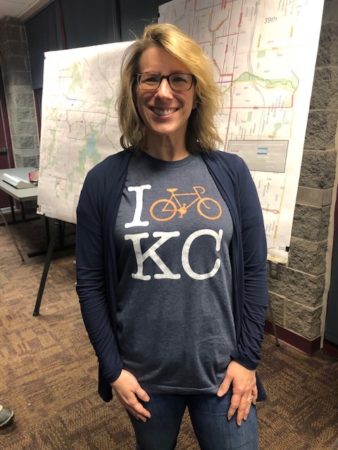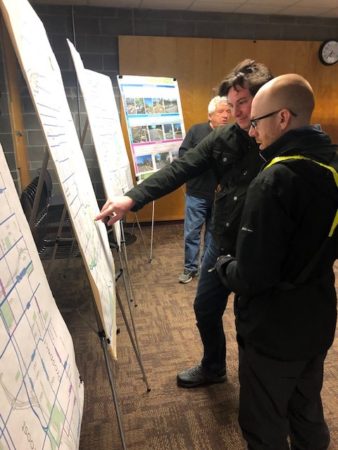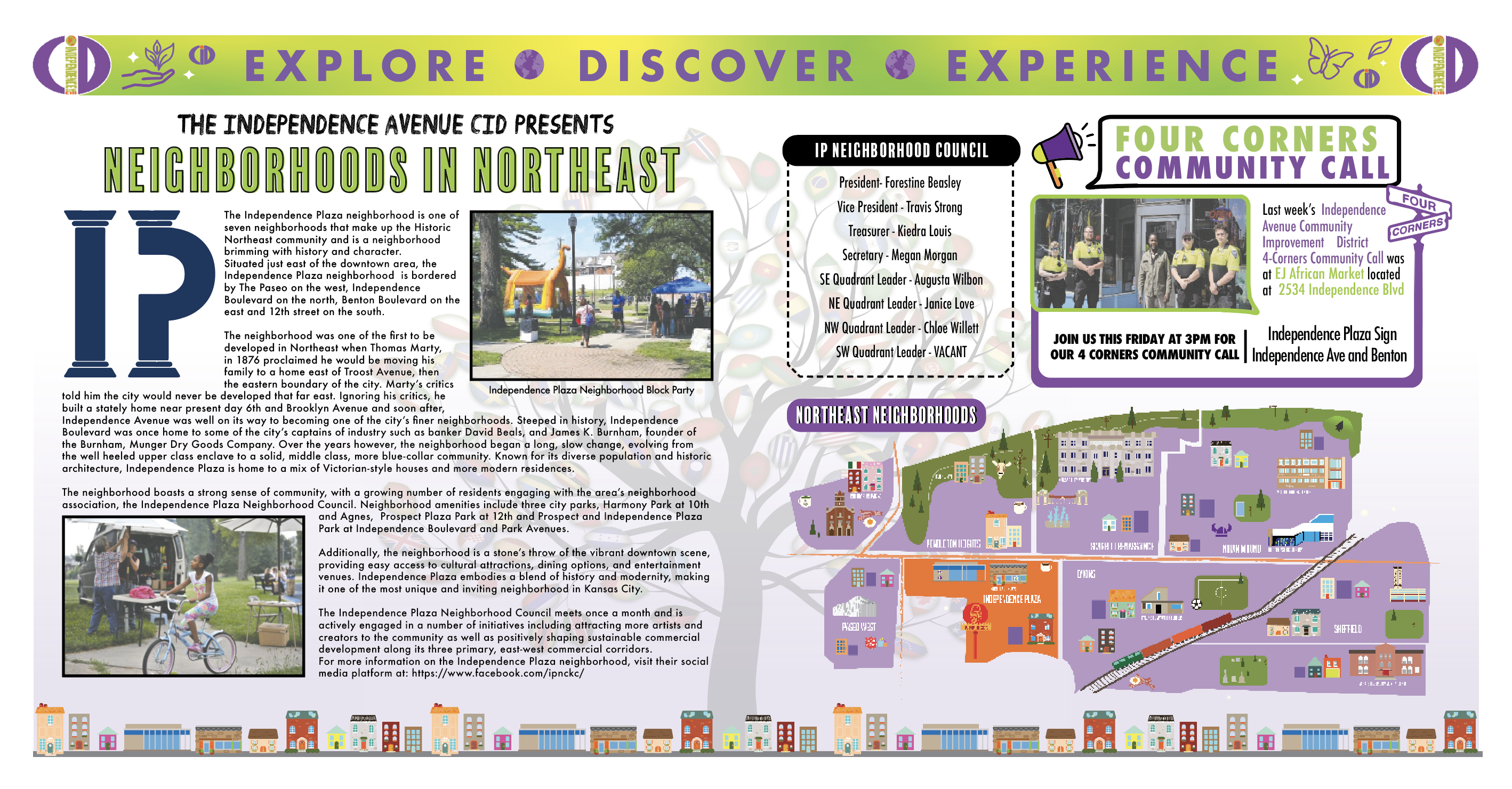
Elizabeth Orosco
Northeast News
Representatives with Bike KC revealed a draft of their 2018 Master Plan at a public meeting Wednesday, Feb. 20. The draft mapped out proposed bike routes, facility types, and at what phase each project was placed. This plan includes a project that runs along Lexington Avenue and Gladstone Boulevard that has many Northeast residents asking questions.
The 2018 Bike KC Master Plan is an update to Bike KC – the city’s current bicycle plan – which was created in 2002.
In December 2016, the City Auditor’s Office released the results of an in-depth audit of the existing Bike KC program and found that the existing Bike KC plan was not sufficient to meet stated City policies and goals. The 2018 Bike KC Master Plan is a direct response to the audit, providing a more specific path forward to help work towards stated City policies and goals.
Bike KC said the purpose of this planning process is to establish a clear vision for bicycling in Kansas City, set specific goals and strategies, prioritize projects or project areas for the future, and to address funding and programmatic elements.
The planning-level estimate for the 2018 Bike KC Master Plan network ranges from $387 to $418 million. The 5-Year Priority Network ranges in cost from $22 to $98 million.
The plan will be presented to Parks and Recreation Board Tuesday, February 26 for consideration. The Bicycle Pedestrian Advisory Committee will hear and consider the plan Monday, March 4, the City Planning Commission will consider the plan for approval Tuesday, March 19, and the plan will be presented to City Council in late March or early April.
The five-year implementation priority network is broken up into three phases. The network of bike routes are designated as one of three facility types: major separation, minor separation, and shared streets.
Major separation is protected bike lanes (also known as cycle tracks – either one-way or two-way) or trails/shared use paths adjacent to the roadway. This includes fully-protected barrier separated bike lanes, such as the project completed on Armour Boulevard last summer, as well as shared use paths.
Minor separation is conventional paint-only bike lanes or painted buffered bike lanes. Minor separation facilities are generally applied appropriately on roadways with lower speeds and traffic volumes.
Shared streets are recommended for calm neighborhood streets. In some cases, shared streets represent existing roadways in developed areas where major or minor separation is not feasible, but the route is a useful or represents a critical connection.
The bike lane project proposed along Lexington and Gladstone Boulevard is set to include major separation of bike lanes and is currently listed as a phase one project.
Joe Blankenship with Bike KC said projects scheduled for phase one begin with a conversation to discuss the plan; phase one does not mean plans have been finalized to begin construction.
“Phase one is the first thing we will examine for implementation,” said Blankenship. “Anything in phase one is a study already underway. That project was already underway when this effort was happening, so methodologically is phase one.”
Bike KC assessed various factors when re-examining the network of bike routes, including level of traffic, crash and dangerous location information, topography, population concentration, important destinations, and others.
Blankenship said the Lexington/Gladstone project is listed under “major separation” for various reasons, including safety.
“The recommendation for major separation on Gladstone Boulevard in this document is based on roadway speed, average daily traffic volume, and if there are already a presence of bike lanes,” he said. “Gladstone is signed at 35 mph. The prevailing speed is 40-45 mph. If a pedestrian or bicyclist is hit by a vehicle traveling at 40 to 45 mph, their likelihood of death is 90 percent. The goal of major separated facilities is to provide a safe space for bikes when there is speeding traffic or a lot of traffic, so that is where the recommendation came from. Individual projects, like this one, look at a lot more granular detail. They look at right of way, they interact with the community, they have a much more thorough dialogue about what the community does or does not want, they look at what the other characteristics of the road are, like parking. Those are the types of things that ultimately determine what goes on the ground. This plan just provides a start to the conversation.”
Maggie Green, Public Information Officer with Public Works gave a brief update on the Lexington/Gladstone project, outlining the current phase.
Green said the staff received plans from the consultants two weeks ago, and feedback from the Northeast neighborhoods have been incorporated into the final plan design. Public Works is currently conducting an internal quality control check prior to making the plans public and once the staff is comfortable with the plans and they have been approved by the Parks and Recreation Development Review Committee, Public Works will host open houses this spring to unveil the final plan design and share other project details.
Many in the Historic Northeast still have questions.
Virginia Bettencourt, who is on the Scarritt Renaissance Neighborhood Association Board, said she feels many in the community have not been included in the conversation regarding this project.
“We are very concerned that they’ve already made a plan for Gladstone that is major separation,” she said. “We do not agree with that because it would take parking away and we don’t want the appearance of our boulevard to change because it’s a wide open, beautiful street. Bike lanes pander to the more elite, well-off city dweller. In our neighborhoods in the Northeast, there is a huge population that is low income and this bike plan doesn’t represent them.”
On the topic of street parking, Green advised that residents in the Northeast neighborhoods did bring up parking concerns and this feedback is being reviewed by design staff.
Green also addressed the issue of public input. She said residents gave feedback during public meetings held in the Fall of 2017.
“Feedback from various neighborhoods have been incorporated in the plans, which will be made public after staff conducts an internal quality control review,” said Green. “Public Works staff values the input of residents and further engagement on this project will take place with open houses prior to construction. Details are currently being worked on (time, date, and location) and will be shared as soon as they become available.”
Bettencourt also mentioned the already-existing Cliff Drive, the officially-designated four-mile State Scenic Byway.
“We have a beautiful Cliff Drive that could and is already accommodating recreational cyclists. Why not make that even better for them and continue it on over to the River Market and make that a designation for cyclists. There are a lot of factors that make us feel very concerned that they have something so invasive already designed for Gladstone Boulevard.”
Richard Plackmeyer, a resident in Historic Northeast, said he is a recreational cyclist, but is concerned about whether this project is actually meeting a need in the community.
“It would disrupt so much of the traffic pattern,” he said. “The problem is that as a community, it’s not a major need, especially if you are going to disrupt everyday life, traffic patterns, and take away street parking. Who is deciding that the cyclists best interest trumps the neighborhood and the residents best interest?”
Plackmeyer also said he has concerns regarding the route chosen to implement the bike lanes. As a recreational cyclist in the Northeast, he is familiar with the streets that are safest and easiest to use for cyclists. He also said residents voices should be taken into consideration before plans are implemented.
“I go up Gladstone, come around the Concourse, hit Independence Avenue and I come downtown,” he said. “I don’t go Lexington. Frankly, it’s dangerous. I’d rather ride the Avenue. The criteria that determines major separation is butting heads with what the residents want and need. I love to cycle. I love to bike. I just don’t like the way this group has been approaching this. What about the residents who live here everyday, own property, pay taxes, and depend on these arteries for transit to get to work– are we saying their wants and needs don’t count?”
Green said in relation to the Lexington/Gladstone project, open houses will enable staff to collaborate with residents and build consensus prior to construction.
“This project is still under development,” she advised. “With relation to adoption of the Bike KC Master Plan (which is a separate effort distinct from the Lexington/Gladstone project) the Parks Department is the first step in the formal adoption process. The City’s Bicycle Pedestrian Advisory Committee will review the plan March 4, the City Plan Commission will review March 19, and the City Council will also formally consider this plan. Each of these meetings are open to the public.”
The Bike KC Plan highlights the issue of transportation in Kansas City. According to the 2011-2015 American Community Survey approximately 11% of Kansas City households do not have access to a vehicle and 41% have access to just one vehicle.
While public transportation is available in the city, the plan hopes to address this issue by providing necessary infrastructure to give residents the option to use bikes as a safe form of transportation.
The plan also discusses the increased use of dockless scooters during the summer of 2018. In just a few months of operation, thousands of residents rode hundreds of thousands of miles on dockless scooters throughout the city, highlighting the interest residents have for a variety of transportation modes.
The plan also cites the issue of safety. Between 2013-2016, four bicyclists and 16 pedestrians were killed and 656 were injured in collisions with motor vehicles in Kansas City, Missouri. The FHWA (2008) notes that providing bike lanes has a crash reduction factor of 36% .
The chance for pedestrian survival when struck by a vehicle going 40 miles per hour is 10 percent. At 30 miles per hour, it is 50 percent. The Bike KC plan considers these statistics when creating recommendations for the network of bike routes throughout the city.
The plan also hopes to help Kansas City become a League of American Bicyclists Bicycle Friendly Community at the silver level by 2024. Currently, Kansas City is at the bronze level. According to the League, building blocks for a Bike Friendly Community include factors such as high speed roads with bike facilities, bicycle education in schools, ratio of total bicycle network mileage to total road network mileage, bicycle friendly laws and ordinances, and a current and implemented bike plan.
For more information on Bike KC and to read the full draft of the 2018 Master Plan, visit kcmo.gov/planning/kc-bike-plan.



















